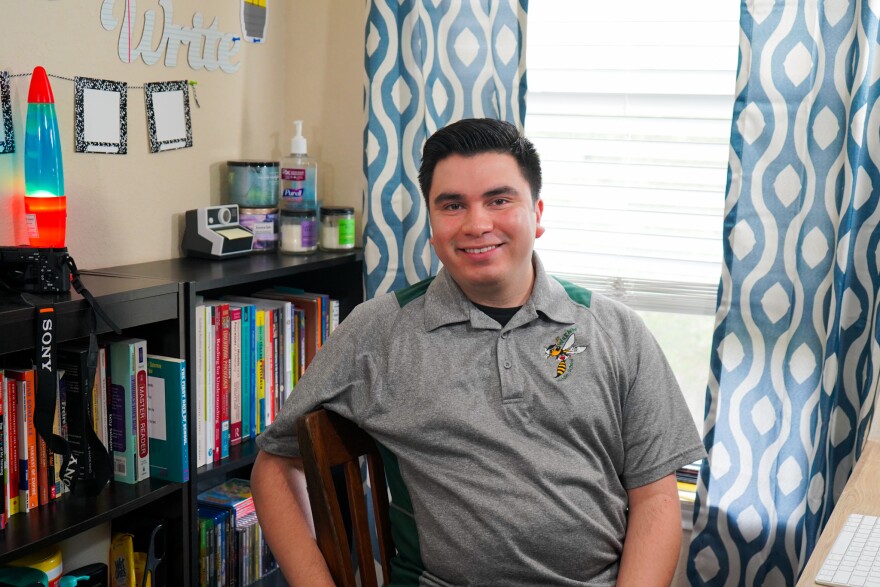Christopher Terrazas never imagined finishing his second year of teaching from a virtual classroom set up in a corner of his family game room at home.
But when the coronavirus pandemic forced schools across the country to close, the 24-year-old San Antonio native embraced the new challenge.
He teaches English Language Arts and Reading to 6th graders at E.T. Wrenn Middle School, the same school he went to as a kid.
Texas Public Radio asked Terrazas to record his experience transitioning from the classroom to the computer screen throughout the month of April.
April 1
On April 1, Terrazas’ biggest challenge was just getting in touch with his students.
“I'm having to use different types of applications to get in contact with them, and try to help them get connected through these online platforms,” Terrazas said. “That consumes a lot of your day…. You're not really getting to dive into curriculum because you're doing other sorts of things.”
Most San Antonio school districts had started online lessons by April 1, but his district, Edgewood, had to wait until its laptop order arrived. Edgewood is one of the area’s highest poverty districts, and many of the district’s students didn’t have the technology they needed to access online lessons.
According to surveys from the U.S. Census, nearly 40% of households in the Edgewood school district don’t have access to the internet.
Only 15 of Terrazas’s 72 students had been able to log into his classroom portal on Microsoft Teams. Families had the option of picking up hard copy instructional packets at the district’s police department, but he had no way of knowing how many of his students were picking them up.
“I wish there was more I could do from my role as a teacher in this position right now,” Terrazas said.
But his first day of recording also had a bright spot: a message from one of his students and their parent.
“They mentioned that they missed school, that they wanted to be in school learning, they miss their friends,” Terrazas said. “Hearing that, I felt incredibly privileged.… It makes me realize, hey, my job is important and there are students who appreciate what (I) do.”

April 2
Terrazas called his next day of recording, April 2, “super productive.” He had a virtual school faculty meeting in the morning and a Q&A with his school leadership team in the afternoon.
“Seeing the investment from other teachers and administration, it's just always good to see that,” Terrazas said.
At this point, he was trying to figure out how to communicate clearly with students now that they were no longer face to face.
“Your words and the way you say things can easily be misinterpreted based off of how you say it,” Terrazas said. “This happened frequently in the classroom, where I will say, ‘Okay, get your paper, and I want you to fold it in half.’ Saying it isn't enough, you also have to demonstrate what you want.”
Terrazas spent the next week and a half piloting lessons with students who had access to computers and were logged in.
One lesson was about the diary of Anne Frank, a teenager who died in the Holocaust. The other was about Helen Keller, who became deaf and blind before the age of 2 and wrote an autobiography, The Story of My Life.
“The section focuses on a teacher who helps a struggling student learn how to adapt in the world,” Terrazas said. “It just fit so perfectly, because I was thinking about this theme of teachers right now and what role do they play.”

April 13
Edgewood started formal online lessons April 13, after the district’s laptop order arrived. Terrazas hosted a video lesson every day, and posted a new reading and writing assignment due at the end of the week.
Thirty-five of his 72 students were now logged into his classroom portal, more than double the number of students from a week and a half before.
“It's not great, but I think for where we started, we're improving. I think maybe it's just not knowing how to access the program” Terrazas said. “And it is overwhelming. It is new.”
Terrazas said he had been able to reach almost everyone in his second period class by phone. Edgewood asked their middle school and high school teachers to call every parent in their second period to make sure every student was contacted at least once.
“Looking at it now, I feel I'm in a much better position, and every parent and every student that I've spoken to so far this week has been very receptive,” Terrazas said. “It's really relieving to know that, hey, they want the same things that I want, they want their kids to still be involved in their schooling.”
The Week of April 20
There are still about 20 students who have not logged into his class portal, but Terrazas is hopeful they’ll all make their way there soon.
And he is excited by the opportunity to embrace technology in his classroom. Terrazas said it’s a natural fit for him and his students because they all grew up during the digital age.
“This is the future, you know, technology is going to be a big part of the future,” Terrazas said. “I think the investment that the schools are making now is a good opportunity for everyone.”
He’s looking forward to his students’ next assignment. They’ll use a social media-like educational tool called FlipGrid to post video interviews of family members’ experiences during the pandemic.
Camille Phillips can be reached at Camille@tpr.org or on Twitter at @cmpcamille.
TPR was founded by and is supported by our community. If you value our commitment to the highest standards of responsible journalism and are able to do so, please consider making your gift of support today.





